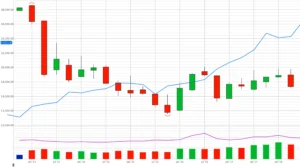Have you ever watched a stock chart, unsure when to jump into a trade? You’re not alone. Trading can feel like navigating a stormy sea, but strong candlestick patterns are like a lighthouse, guiding you to safer entry points. These price action patterns reveal market sentiment, helping traders spot bullish and bearish candlestick patterns or candlestick reversal signals to time trades with confidence. As a trader, I’ve relied on these patterns to make sense of price movements, and in this guide, I’ll share how you can use them to fine-tune your trade entries, with real-world examples to bring it all to life.
What Are Candlestick Patterns?
Candlestick patterns are visual snapshots of price movements over a specific time, like a day or an hour. Each candlestick shows four key points: the open, high, low, and close prices. The body reflects the difference between open and close, while wicks show the highest and lowest prices. These patterns are a cornerstone of technical analysis for traders, offering clues about whether buyers or sellers are in control.
By mastering price action patterns, you can pinpoint moments when the market shifts, signalling ideal times to enter or exit trades. Strong candlestick patterns shine in trending markets, where they confirm trend directions or highlight candlestick reversal signals. But their power depends on context, like market trends or volume, and confirmation from other tools.
Why Use Candlestick Patterns for Trade Entry?
Some candlestick patterns are more reliable than others. Strong candlestick patterns, like the hammer or bullish engulfing, often signal major market shifts with up to 70% accuracy in trending markets, according to Technical Analysis of the Financial Markets by John J. Murphy. These patterns help you decide when to enter a trade, whether it’s a bullish reversal or a bearish exit point.
Pairing these patterns with technical analysis for traders tools, like moving averages or volume, boosts their reliability. For example, a pattern at a key support level is more likely to lead to a winning trade. Understanding the market’s mood—trending or range-bound—helps you use these price action patterns to nail your trade entries.
Top Bullish Candlestick Patterns
Bullish patterns signal potential upward reversals, often appearing after a downtrend. Let’s explore some key patterns and ask: Which of these might you trust most in a declining market?
Hammer
The hammer forms at the bottom of a downtrend, featuring a small body with a long lower wick, at least twice the body’s length. It indicates strong buying pressure after initial selling. A green hammer suggests a stronger bullish signal. Why might a green hammer be more convincing than a red one? Traders often wait for a bullish candle the next day to confirm the reversal.
Bullish Engulfing
This two-candlestick pattern signals a shift from bearish to bullish sentiment. A small red candle is followed by a larger green candle that engulfs the previous day’s body, showing buyer dominance. What does the size of the engulfing candle tell you about market momentum? Confirmation comes when the second candle closes above the first candle’s midpoint.
Morning Star
The morning star is a three-candlestick pattern indicating a bullish reversal. It includes a long red candle, a small-bodied candle (showing indecision), and a long green candle. Why might a three-candle pattern be more reliable than a single-candle one? The third candle closing above the first candle’s midpoint confirms the shift to bullish sentiment.
Three White Soldiers
This pattern features three consecutive long green candles with small wicks, each opening within the previous candle’s body and closing higher. It signals sustained buying pressure. How might increasing volume strengthen this pattern’s signal? This pattern often marks the start of a strong uptrend.
Top Bearish Candlestick Patterns
Bearish patterns signal potential downward reversals, often forming after an uptrend. Which of these patterns might catch your attention in a rising market?
Shooting Star
The shooting star forms at the top of an uptrend, with a small body and a long upper wick, indicating buyers pushed the price up, but sellers drove it back down. What does this tug-of-war suggest about market sentiment? A bearish candle the next day confirms the reversal.
Bearish Engulfing
This two-candlestick pattern signals a shift from bullish to bearish sentiment. A small green candle is followed by a larger red candle that engulfs the prior day’s body. Why might the size of the red candle matter? Confirmation occurs when the second candle closes below the first candle’s midpoint.
Evening Star
The evening star, a three-candlestick pattern, includes a long green candle, a small-bodied candle, and a long red candle. It signals weakening buying pressure. How might indecision in the middle candle affect your trading decision? The third candle closing below the first candle’s midpoint confirms the bearish shift.
Three Black Crows
This pattern consists of three consecutive long red candles with small wicks, each opening within the prior candle’s body and closing lower. It indicates strong selling pressure. What role might volume play in confirming this pattern? It often signals the start of a downtrend.
Other Notable Patterns
Beyond reversals, continuation and indecision patterns provide valuable insights. How might these patterns influence your decision to hold or exit a trade?
Doji
A doji candle has nearly identical open and close prices, forming a small body. It signals market indecision, often appearing before a reversal or continuation. Why might indecision be a critical signal in a trending market? Its significance depends on the preceding trend and confirmation.
Spinning Top
A spinning top has a small body with long upper and lower wicks, indicating indecision. It suggests neither buyers nor sellers dominate. How could this pattern help you anticipate a market pause? It often signals consolidation after a trend.
Marubozu
A marubozu candle has no wicks, showing strong directional movement. A bullish marubozu (long green body) indicates buyer control, while a bearish marubozu (long red body) shows seller dominance. What might a lack of wicks tell you about market conviction? These patterns suggest trend continuation.
Strategies for Smarter Trade Entries
To nail trade entries with strong candlestick patterns, try these tips:
- Confirm Signals: Wait for a confirming candle or indicator, like a moving average crossover, before entering. A bullish engulfing followed by a green candle strengthens the entry.
- Check Context: Patterns in trending markets outperform those in choppy markets. A hammer at a support level is a stronger buy signal.
- Manage Risk: Set stop-loss orders to limit losses. Place a stop below a hammer’s low to protect against false signals.
Table: Candlestick Patterns for Trade Entry
| Pattern | Type | Signal | Best Entry Context |
|---|---|---|---|
| Hammer | Bullish | Reversal after downtrend | Support level, high volume |
| Inverted Hammer | Bullish | Reversal after downtrend | Confirmation candle, support level |
| Bullish Engulfing | Bullish | Reversal after downtrend | Strong volume, trend context |
| Morning Star | Bullish | Reversal after downtrend | Middle candle indecision, volume |
| Three White Soldiers | Bullish | Continuation or reversal | Consistent higher closes, volume |
| Shooting Star | Bearish | Reversal after uptrend | Resistance level, high volume |
| Bearish Engulfing | Bearish | Reversal after uptrend | Strong volume, trend context |
| Evening Star | Bearish | Reversal after uptrend | Middle candle indecision, volume |
| Three Black Crows | Bearish | Continuation or reversal | Consistent lower closes, volume |
| Doji | Neutral | Indecision, potential shift | Preceding trend, confirmation candle |
| Marubozu | Bullish/Bearish | Strong trend continuation | No wicks, high volume |
Real-Life Trading Examples
Imagine trading NVIDIA Corp. (NVDA) in a downtrend. A hammer forms at $100, a known support level, with high volume. The next day, a green candle confirms the reversal. You enter a long position at $102, set a stop-loss at $98, and target $110 based on resistance. This price action pattern nails the entry.
On the flip side, for TSLA in an uptrend, a shooting star forms at $900, near resistance. A red candle confirms the reversal. You exit your long or enter a short at $890, with a stop-loss at $910 and a target of $870, using the candlestick reversal signal.
Avoid These Mistakes
Traders often trip up with strong candlestick patterns. Avoid these errors:
- Skipping Confirmation: Entering without a confirming candle risks false signals.
- Ignoring Market Context: Patterns in range-bound markets are less reliable.
- Overlooking Volume: Low volume weakens a pattern’s signal, as it shows limited participation.
Use technical analysis for traders and confirm signals with tools like RSI to stay on track.
Boosting Entries with Technical Tools
To sharpen your trade entries with strong candlestick patterns, combine them with:
- Moving Averages: A hammer above a 50-day moving average strengthens the buy signal.
- Volume Analysis: High volume on a bullish engulfing pattern confirms buyer commitment.
- Support/Resistance: Patterns near key levels are more likely to succeed.
For example, a morning star at a 200-day moving average with rising volume is a rock-solid entry signal.
Wrapping Up
Strong candlestick patterns are your secret weapon for timing trade entries. Patterns like the hammer, bullish engulfing, and morning star offer reliable bullish and bearish candlestick patterns, while shooting star and bearish engulfing provide critical candlestick reversal signals. By blending these price action patterns with technical analysis for traders, you can master your trade entries. Stay curious, confirm signals, and manage risk to trade smarter.
Read here to learn more about “Trend Trading That Works: 4 Tools for Smarter Entries“

I’m Chaitali Sethi — a seasoned financial writer and strategist specializing in Forex trading, market behavior, and trader psychology. With a deep understanding of global markets and economic trends, I simplify complex financial concepts into clear, actionable insights that empower traders at every level. Whether it’s dissecting winning strategies, breaking down market sentiment, or helping traders build the right mindset, my content bridges the gap between information and implementation.




